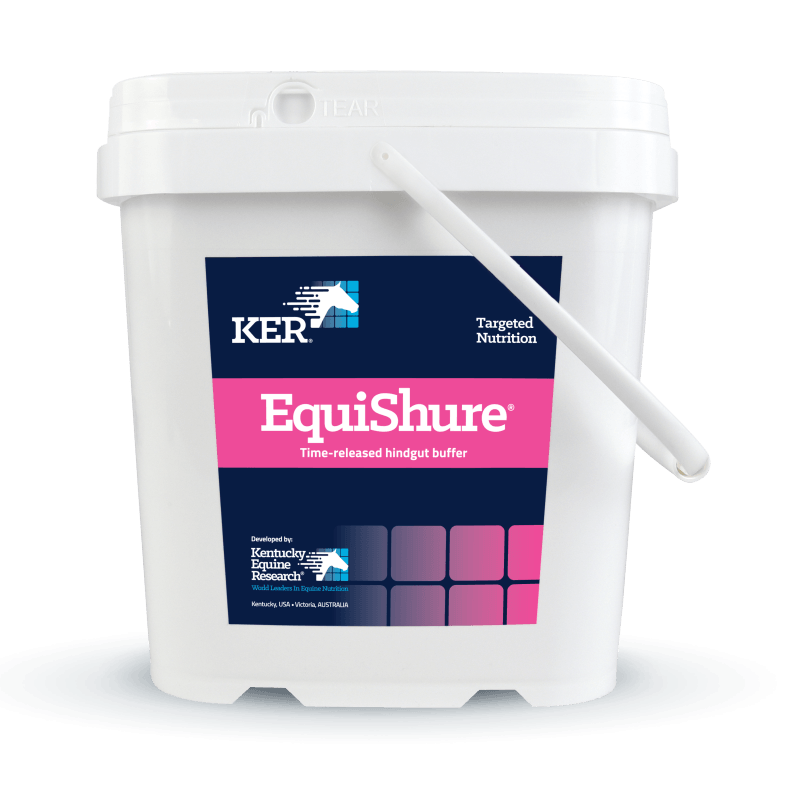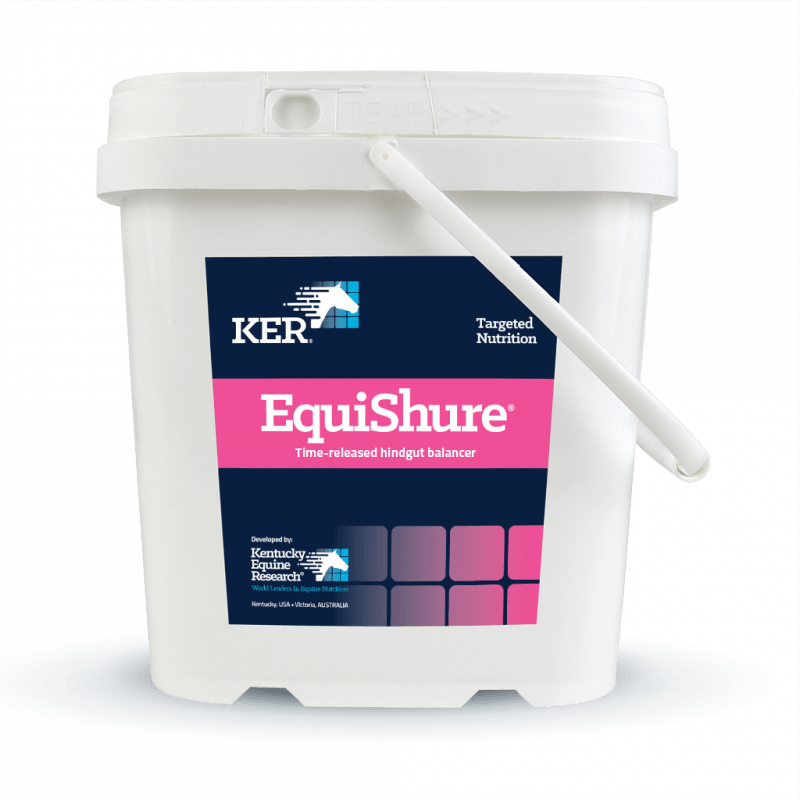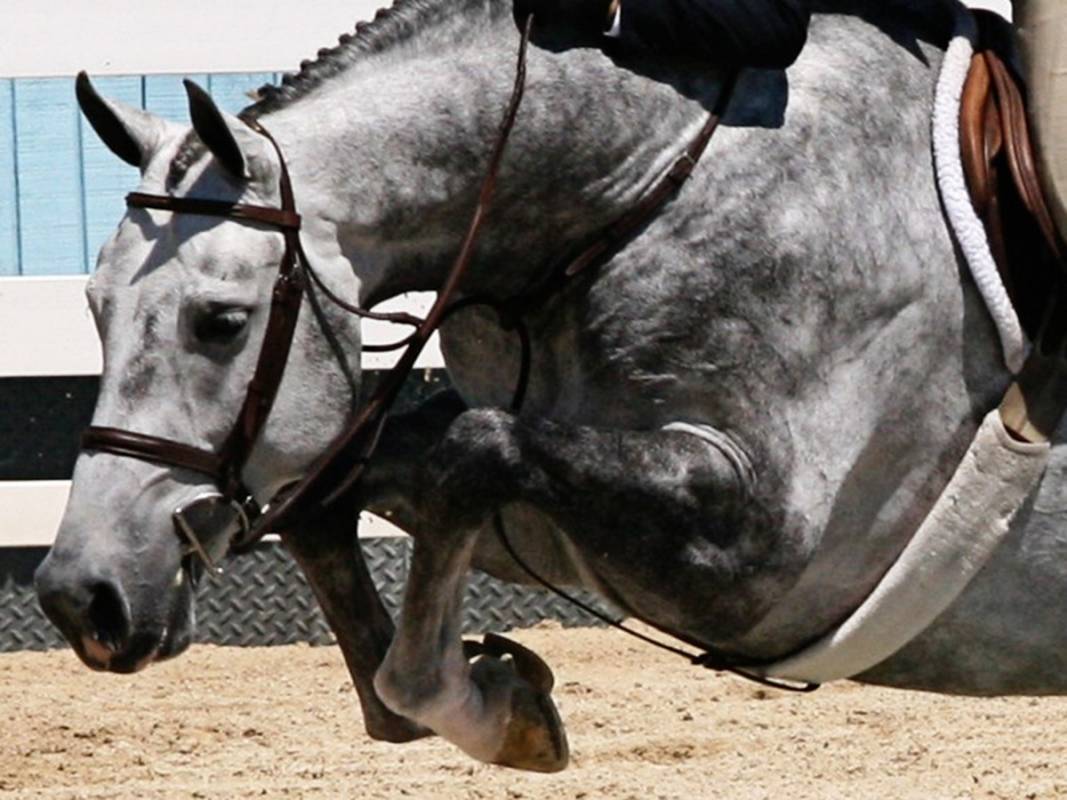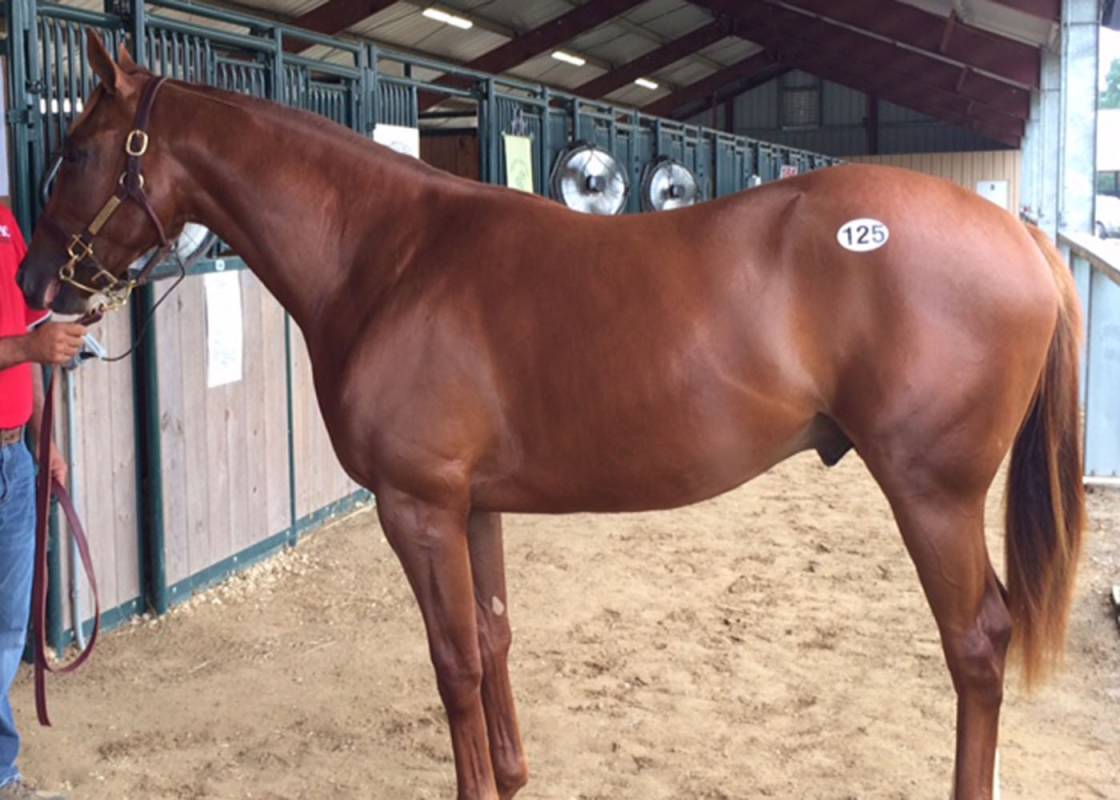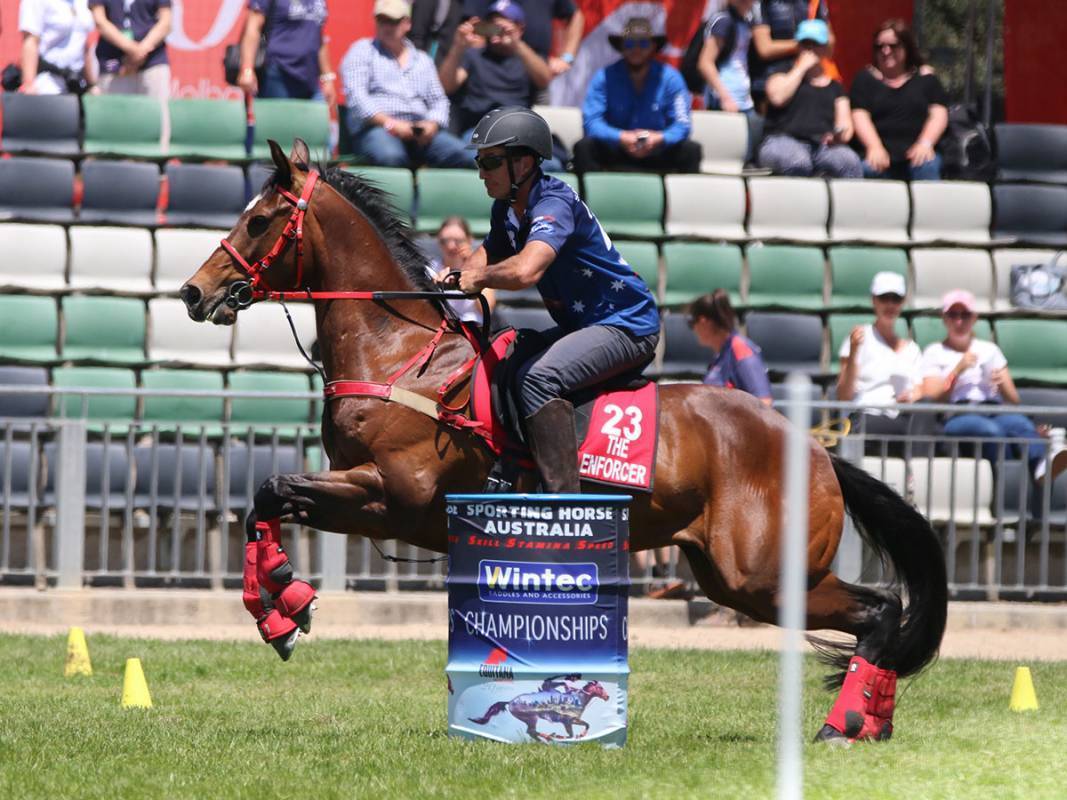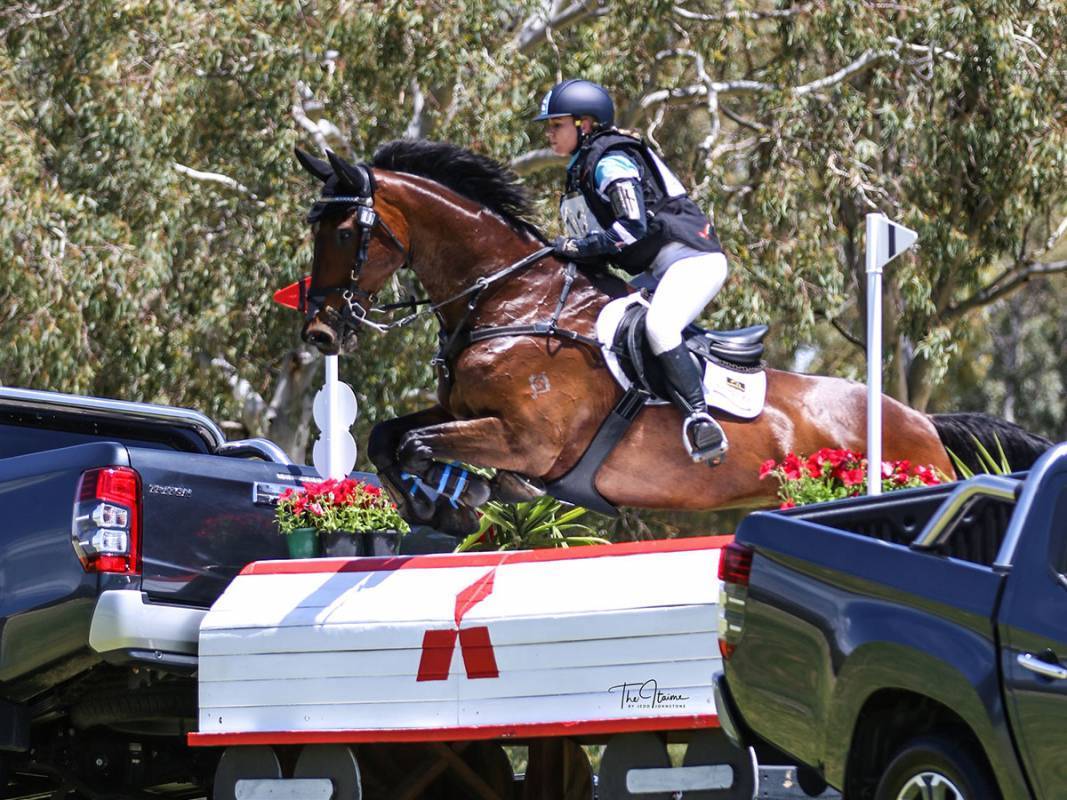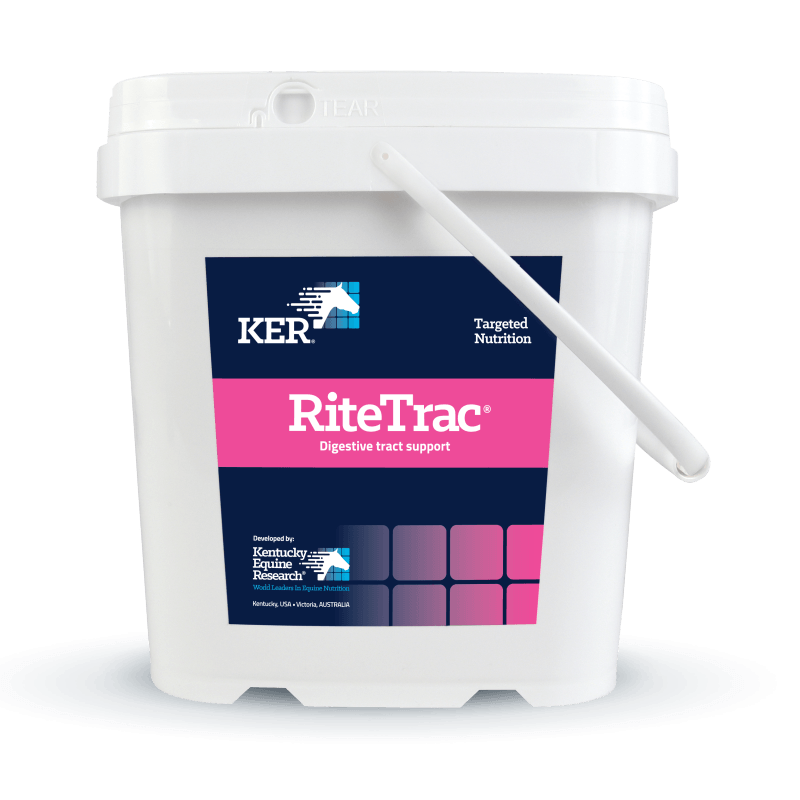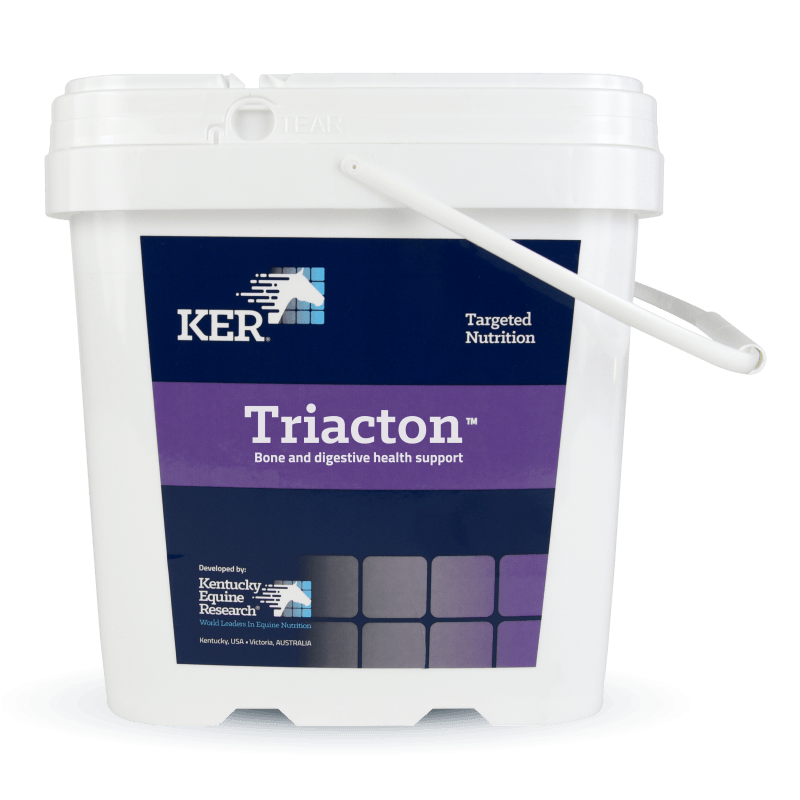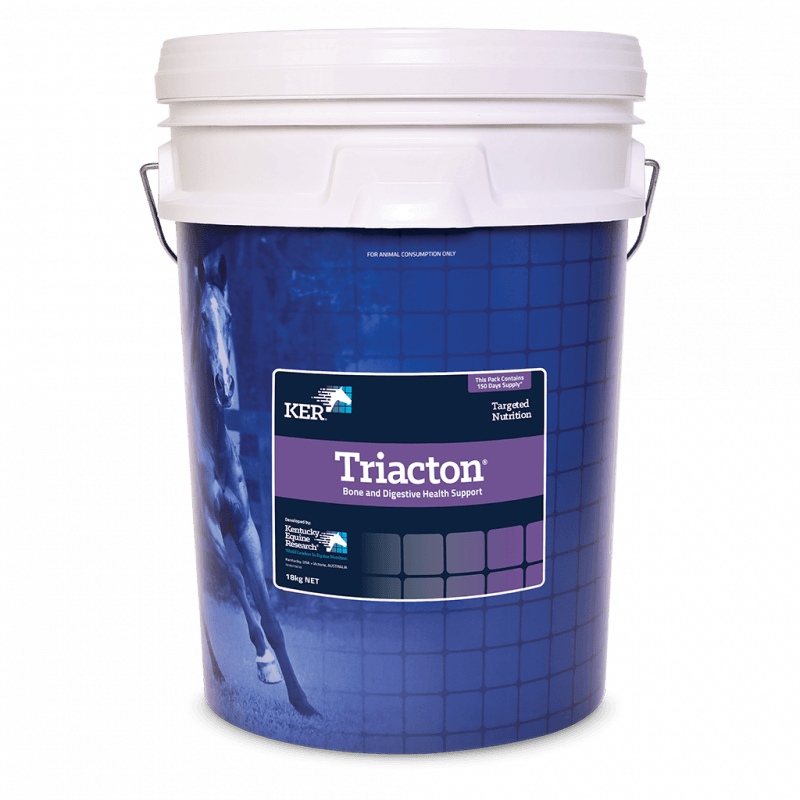EquiShure® is a time-released buffer targeting the hindgut. Research supports the use of a hindgut buffer in cases of high grain and high fructan intake. Up to 70% of the horse’s energy is derived from fermentation in the hindgut. The pH of the hindgut varies as bacterial populations increase and decrease in response to dietary modifications. An acidic shift, which can be caused by carbohydrate-rich meals, favors the growth of acid-loving bacteria, while other microbes die in the same conditions.
Changes in the pH of the hindgut due to alterations in the microbial populations and acid profiles cause a condition known as subclinical acidosis, which can put affected horses at a higher than normal risk for colic and laminitis. Other signs of subclinical acidosis include decreased feed intake or complete inappetence in severe cases, mild to moderate colic signs of unexplained origin, poor feed efficiency and subsequent weight loss, loss of performance, and development of certain vices such as wood chewing, weaving, and stall walking.
EquiShure’s unique, patented encapsulation technology ensures targeted release directly in the hindgut.
EquiShure®promotes normal digestive function by aiding in the maintenance of an optimal hindgut environment and is designed for horses suspected of suffering from or that are at risk of developing hindgut acidosis.
Many horses have hindgut disturbances and EquiShure’s unique encapsulation technology ensures targeted release directly in the hindgut. The demands placed on horses, as both athletes and breeding animals, dictate that substantial quantities of energy–rich feeds be consumed. Disturbances in the normal hindgut environment are thought to result from overconsumption of either high–starch concentrates or pasture grasses rich in fructans (sugars).
Hindgut acidosis leads to changes in the bacterial population of the hindgut, digestive disturbances, and reduced digestive efficiency. EquiShure supplies a time-released balancer to neutralise the acid and help maintain a stable hindgut environment, which encourages proper digestion and absorption of nutrients.
EquiShure’s unique encapsulation technology ensures targeted release directly in the hindgut.
EquiShure is recommended for horses:
- On high-grain diets or grazing lush pasture
- With inappetence or weight loss
- With unexplainable behavioral problems
- With digestive upsets resulting in loose manure
- Prone to recurrent mild colic or laminitis
- Sport horses under stress of training
Why use EquiShure?
- Helps maintain normal digestive function and an optimal hindgut environment
- Patented encapsulation technology allows for targeted delivery of sodium bicarbonate to the hindgut and prevents an effect on blood tCO2 levels
- Stabilises and maintains normal hindgut pH to reduce the risk of hindgut acidosis and associated disorders
- May help improve digestive efficiency
When to use EquiShure
- Horses on moderate or high grain diets
- Horses grazing on lush pasture
- Horses with digestive upsets resulting in loose manure
- Horses prone to recurrent mild colic
- Inappetence or picky eaters and poor doers or prone to weight loss
- Horses with unexplainable behaviour problems
- Horses under stress of training, travel or sales preparation
Research Proven
Fecal examination indicated that nonsupplemented horses had decreased fecal pH after feeding when compared to horses supplemented with EquiShure hindgut buffer.
Cause of Subclinical Acidosis
One of the primary signs of subclinical acidosis is inappetence or decreased appetite. A horse is often reported to be “off his feed.” Because the hindgut is overwhelmed with lactic acid when a horse is experiencing acidosis, the intestinal lining becomes inflamed and irritated, causing the horse discomfort. The irritation may be severe enough to induce behavior characteristic of colic. Furthermore and perhaps most detrimental to equine athletes is a reduction of feed efficiency. Long-term exposure of the intestinal lining to a low-pH environment may negatively affect the absorptive capacities of these structures, limiting the amount of energy available for performance.
In addition to these health concerns, a link between subclinical acidosis and sterotypies such as wood chewing, weaving, and stall walking has been suggested by researchers. Because of the precarious nature of the hindgut of a horse afflicted with subclinical acidosis, it is less able to handle metabolic crises that healthy horses may be able to fend off. Hence, horses with subclinical acidosis are more susceptible to colic and laminitis.
Proven Time-Released Buffer
Research trials at Kentucky Equine Research (KER) were designed to test the efficacy of EquiShure® on hindgut acidosis in horses fed a high-grain ration. Fecal examination indicated that nonsupplemented horses had decreased fecal pH after feeding when compared to horses supplemented with EquiShure hindgut buffer (Figure 1). In addition, EquiShure supplemented horses had significantly lower fecal lactate concentrations, suggesting that lactate was being used by lactic-acid-utilizing bacteria to produce VFA. The VFA are subsequently absorbed by the intestine and are metabolized as an energy source in the liver. These significant results suggest that EquiShure prevented the decrease in pH associated with rapid starch and sugar fermentation after a large grain meal, enabling lactate-utilizing bacteria to thrive and convert lactate into VFA.
Subclinical acidosis can also be caused by pasture grasses rich in fructan. Microbial digestion of fructans results in production of VFA and lactic acid similar to cereal grain digestion in the hindgut. As with large amounts of grain, high fructan intakes overwhelm the hindgut resulting in rapid fermentation, accumulation of lactic acid, and a deleterious decrease in pH. KER therefore tested the efficacy of EquiShure against a challenge of fructan. Results showed that EquiShure-supplemented horses had less fecal lactate when compared to control horses (Figure 2), which, like in the grain study, indicates that lactate is being converted into VFA by lactic-acid-utilizing bacteria. However, both groups of horses exhibited decreased fecal pH. In control horses, both lactic acid and VFA contributed to the acidic conditions, whereas in EquiShure-treated horses, most of the lactic acid was being utilized. Low pH as the result of VFA is less detrimental to hindgut function compared with lactate, which is a much stronger acid.
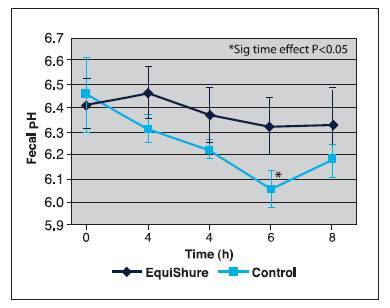
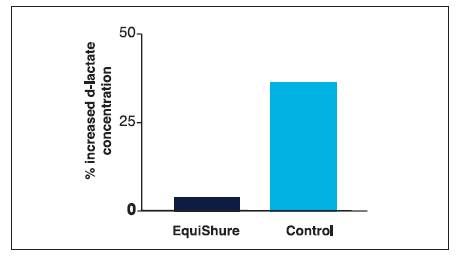
Another study demonstrated the efficacy of EquiShure given to horses that had been denied access to pasture (for example, due to injury-related stall rest). Horses that had not been turned out on pasture for several weeks were given 24-hour free-choice access to fall pasture. One group of horses was given EquiShure for 1 week prior to turnout and another group served as controls and was given no buffer. Initial pH readings revealed a moderate decrease in pH despite the buffer, but an analysis of VFA proved that the drop in pH was associated with increased VFA production; therefore more were being produced and available to the horse as energy sources (Figure 3). Additional analysis demonstrated that lactic acid was greater in the control group vs. the EquiShure-fed group, which meant EquiShure was effective and the hindgut was functioning optimally (Figure 4).
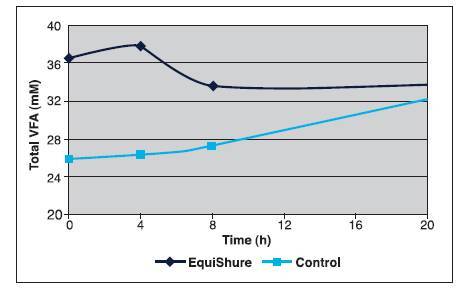
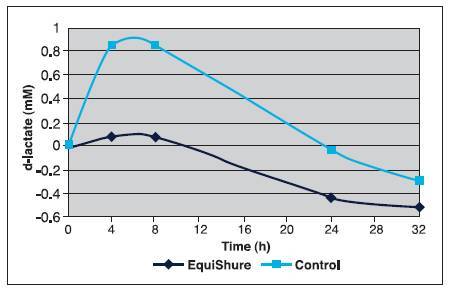
A time-released buffer helps moderate gut conditions by preventing the drastic drop in pH associated with high lactate production and supports lactic-acid-utilizing bacteria to enhance the natural production of VFA from starch and cellulose. While VFA are weak acids and will reduce pH, the dramatic effects of lactic acidosis are moderated and the associated problems attenuated by the time-released buffer EquiShure.
Feeding Directions
Use table below to determine recommended daily amount based on horse’s grain intake, forage source, and weight. Top-dress EquiShure on daily grain ration. For best results divide recommended daily amount equally among grain meals. 1 scoop = 30 g.
| Weight of Horse | 300 kg (660 lb) | 500 kg (1100 lb) | 600 kg (1320) | |
|---|---|---|---|---|
| Grain Intake | Forage Source | Amount of EquiShure per day | ||
| Low to moderate | Mostly hay | 30-60 g | 60-90 g | 90-120 g |
| Low to moderate | Mostly pasture | 30-60 g | 60-90 g | 90-120 g |
| Moderate to high | Mostly hay | 60-90 g | 90-120 g | 120-150 g |
| Moderate to high | Mostly pasture | 90-120 g | 120-150 g | 150-180 g |
Feeding guidelines for racehores: Trainers and managers should adhere to the regulations set forth by specific racing jurisdictions prior to using any feed additives or supplements. HISA Compliance
EquiShure is a registered trademark of Balchem Corporation.
Feeding Directions
Top–dress EquiShure on feed. Feed 30-150g (1-5 scoops) daily according to the horse’s size and diet. For best results, divide the amount equally among feedings.
Use table below to determine recommended daily amount based on horse’s grain intake, forage source, and weight. 1 scoop = 30 g.
| Weight of Horse | 300 kg (660 lb) | 500 kg (1100 lb) | 600 kg (1320) | |
|---|---|---|---|---|
| Grain Intake | Forage Source | Amount of EquiShure per day | ||
| Low to moderate | Mostly hay | 30-60 g | 60-90 g | 90-120 g |
| Low to moderate | Mostly pasture | 30-60 g | 60-90 g | 90-120 g |
| Moderate to high | Mostly hay | 60-90 g | 90-120 g | 120-150 g |
| Moderate to high | Mostly pasture | 90-120 g | 120-150 g | 150-180 g |
EquiShure Use in Racehorses
EquiShure can be used in racehorses. Its use is covered by the ‘Clear Day rule’ in the Australian Rules of Racing for the use of alkalinizing agents. We recommend stopping this product 24 hours prior to racing.
EquiShure is a registered trademark of Balchem Corporation.
